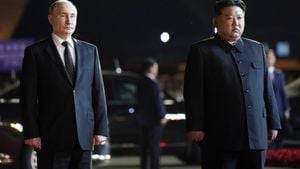Russian military activities around Zaporizhzhia, one of Ukraine's key cities, have captured attention as speculations about potential offensives swirl. Although recent discussions have hinted at the possibility of Russian forces gearing up for a large-scale operation, the reality on the ground appears quite different. Andrii Kovalenko, the head of Ukraine's Center for Countering Disinformation at the National Security and Defense Council, has shed light on the situation, stating emphatically, "Russian forces lack the strength for an offensive on Zaporizhzhia."
Instead of focusing on the city itself, reports suggest the Russians are strategically preparing for tactical assault operations surrounding several settlements nearby. Specifically, Kovalenko mentioned the Kurakhove direction as being integral to these planned operations within the wider Zaporizhzhia region. This shift suggests a more regional approach rather than direct assaults on the city, creating different dynamics within the conflict.
Interestingly, there's speculation about Russian military correspondents possibly exacerbated public fears by embellishing these operational plans, leading to increased uncertainty among residents. This tactic of fear-mongering may be aimed at sowing confusion or complicity among the Ukrainian side, as well as maintaining domestic support for Russia's military actions.
Despite the lack of immediate threats against Zaporizhzhia proper, there are signs of heightened military tensions and provocations from the Russian side. Media reports have consistently warned of troop movements near the area, pointing to the potential for sudden escalations. Ukrainian Defense Forces remain vigilant and well-prepared for any surprises. Their strategy includes not only bracing for worst-case scenarios but also actively responding to the rapid developments on the ground.
Recent shelling incidents have intensified concerns. For example, on November 11, 2022, multiple explosions rocked Zaporizhzhia. Russian forces launched three aerial bombings within the city, resulting tragically in one fatality and leaving three others injured. The night afterward, the situation worsened as Russian military strikes on residential buildings trapped several people, amplifying the visible human toll of this conflict.
With every incident, the resilience of the Ukrainian people becomes more apparent, yet the fear and uncertainty permeate the atmosphere. Local authorities and military forces are on high alert, with communities bracing for potential retaliatory actions. The emotional weight of living under constant threat cannot be overstated for the residents of Zaporizhzhia, who have already endured significant hardships since the conflict began.
On the broader scale, discussions persist over when and if Russia might orchestrate any significant military push toward Zaporizhzhia, as they have done elsewhere. The perspectives offered by military analysts and experts highlight the complex matrix of military logistics, troop morale, and operational capabilities currently defined by the conflict's past months.
While Russian troops might muster appearances of readiness, the practical capabilities to sustain an all-out offensive seem limited at this juncture. Observers remain cautious; the potential for significant Russian movements still looms large, but current assessments suggest disparity between perceived strength and actual operational readiness.
This reality poses questions not just about the fate of Zaporizhzhia but the overall strategic picture of the Ukraine war. With each passing day, as dynamics shift, both sides must remain acutely aware of the potential fallout from missteps. Diplomatic efforts continue to play out on the international stage, as the world remains focused on the conflict’s twists and impacts.
For the people of Zaporizhzhia, fear persists amid the flickering hope for peace. Will they remain untouched amid these strategic machinations, or will the creeping uncertainty finally culminate in something more concrete? Only time will tell.



